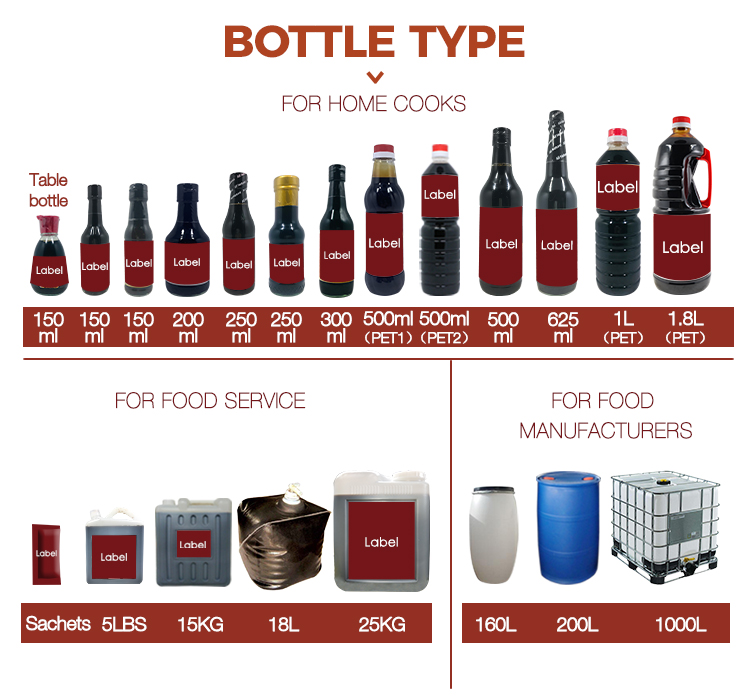TSY or Custom Brands
| Availability: | |
|---|---|
| Quantity: | |








Parameters About TSY Japanese Sushi Soy Sauce
| Flavor | Salty and a little sweet, delicious, fragrant and smooth |
| Ingredient | Soy bean,Water,Salt,Wheat Flour,Sugar,Caramel (E150C) ,Yeast Extract, Monosodium Glutamate (E621) |
| Serving Suggestion | It is mainly used for dipping sushi, sashimi, etc |
| Nutrition information typical values per 100g | Energy 211kJ/51Kcal Protein 10.9g Total fat 0g Carbohydrate 1.5g Sodium 7248mg |
| Shelf Life | 24 months |
| STORAGE: | Keep at room temperature and moisture proof storage. Please closed After opening use,and store in dry cool place. |
| Certificate | HACCP, BRC, IFS, HALAL, KOSHER, ISO |
Using bottled Japanese sushi soy sauce is quite straightforward. Here's how:
1. Pouring: Open the bottle of sushi soy sauce by removing the cap or unsealing it. Hold the bottle over your sushi or desired dish and gently pour a small amount of soy sauce onto your food.
2. Dipping: Sushi soy sauce is typically used as a dipping sauce. If you're enjoying sushi, sashimi, or other Japanese dishes, you can pour a small amount of soy sauce into a small dish. Dip your sushi or other items into the soy sauce before eating. Be mindful not to use too much, as it can overpower the flavors.
3. Moderation: Japanese soy sauce is known for its strong and salty flavor, so use it in moderation. You can always add more if needed, but it's harder to dilute if you've added too much.
4. Experiment: Feel free to mix soy sauce with wasabi or other condiments to create your own dipping sauce with a twist. However, make sure not to overpower the delicate flavors of the sushi or dish you're enjoying.
5. Storage: After using, make sure to cap the bottle tightly and store it in a cool, dark place to preserve its freshness.
Remember, the key is to enhance the flavors of your food without overwhelming them. Enjoy your sushi and the delicious flavors of Japanese soy sauce!
Parameters About TSY Japanese Sushi Soy Sauce
| Flavor | Salty and a little sweet, delicious, fragrant and smooth |
| Ingredient | Soy bean,Water,Salt,Wheat Flour,Sugar,Caramel (E150C) ,Yeast Extract, Monosodium Glutamate (E621) |
| Serving Suggestion | It is mainly used for dipping sushi, sashimi, etc |
| Nutrition information typical values per 100g | Energy 211kJ/51Kcal Protein 10.9g Total fat 0g Carbohydrate 1.5g Sodium 7248mg |
| Shelf Life | 24 months |
| STORAGE: | Keep at room temperature and moisture proof storage. Please closed After opening use,and store in dry cool place. |
| Certificate | HACCP, BRC, IFS, HALAL, KOSHER, ISO |
Using bottled Japanese sushi soy sauce is quite straightforward. Here's how:
1. Pouring: Open the bottle of sushi soy sauce by removing the cap or unsealing it. Hold the bottle over your sushi or desired dish and gently pour a small amount of soy sauce onto your food.
2. Dipping: Sushi soy sauce is typically used as a dipping sauce. If you're enjoying sushi, sashimi, or other Japanese dishes, you can pour a small amount of soy sauce into a small dish. Dip your sushi or other items into the soy sauce before eating. Be mindful not to use too much, as it can overpower the flavors.
3. Moderation: Japanese soy sauce is known for its strong and salty flavor, so use it in moderation. You can always add more if needed, but it's harder to dilute if you've added too much.
4. Experiment: Feel free to mix soy sauce with wasabi or other condiments to create your own dipping sauce with a twist. However, make sure not to overpower the delicate flavors of the sushi or dish you're enjoying.
5. Storage: After using, make sure to cap the bottle tightly and store it in a cool, dark place to preserve its freshness.
Remember, the key is to enhance the flavors of your food without overwhelming them. Enjoy your sushi and the delicious flavors of Japanese soy sauce!
This specification of Japanese Sushi Soy Sauce are cost-effective.

SPECIFIATION PER CTN | BOTTLE TYPE | CTNS/20'GP |
150ml*12btls/box*4boxes | Glass bottle | 1010 |
150ml*24btls | Table bottle | 1855 |
200ml*24btls | Glass bottle | 1550 |
250ml*24btls | Glass bottle | 1550 |
300ml*12btls | Glass bottle | 1550 |
500ml*12btls | Glass bottle | 1550 |
625ml*12btls | Glass bottle | 1330 |
1000ml*12btls | Plastic bottle | 1224 |
1.86L*6jar | Plastic jar | 1400 |
5L*4jar | Plastic jar | 756 |
8L*2jar | Plastic jar | 1150 |
18L*1bag/box | Faucet soft bags | 1008 |
15kg*2drum | Plastic drum | 700 |
25kg*1drum | Plastic drum | 800 |
160L*1drum | Plastic drum | 100 |
200L*1drum | Plastic drum | 80 |
1000L*1drum | Plastic drum | 20 |
* If you have other needs, please consult us.

This specification of Japanese Sushi Soy Sauce are cost-effective.

SPECIFIATION PER CTN | BOTTLE TYPE | CTNS/20'GP |
150ml*12btls/box*4boxes | Glass bottle | 1010 |
150ml*24btls | Table bottle | 1855 |
200ml*24btls | Glass bottle | 1550 |
250ml*24btls | Glass bottle | 1550 |
300ml*12btls | Glass bottle | 1550 |
500ml*12btls | Glass bottle | 1550 |
625ml*12btls | Glass bottle | 1330 |
1000ml*12btls | Plastic bottle | 1224 |
1.86L*6jar | Plastic jar | 1400 |
5L*4jar | Plastic jar | 756 |
8L*2jar | Plastic jar | 1150 |
18L*1bag/box | Faucet soft bags | 1008 |
15kg*2drum | Plastic drum | 700 |
25kg*1drum | Plastic drum | 800 |
160L*1drum | Plastic drum | 100 |
200L*1drum | Plastic drum | 80 |
1000L*1drum | Plastic drum | 20 |
* If you have other needs, please consult us.

Japanese sushi soy sauce, also known as shoyu, is a condiment that adds flavor to sushi and various other dishes. However, it is essential to note that soy sauce is relatively low in nutrients. Here are the main components of Japanese sushi soy sauce:
1. Sodium: Soy sauce is high in sodium, which is primarily responsible for its salty taste. High sodium intake should be moderated as excessive consumption can be detrimental to health, especially for those with high blood pressure or certain health conditions.
2. Protein: While soy sauce does contain some protein, the amount is relatively small and not a significant source of protein in the diet.
3. Amino acids: Soy sauce contains essential amino acids, such as glutamic acid and aspartic acid, which contribute to its umami flavor.
4. Carbohydrates: Soy sauce contains a small amount of carbohydrates, mainly in the form of simple sugars.
5. Iron: Soy sauce contains a small amount of iron, but it is not a significant source of this essential mineral.
Overall, while soy sauce can add flavor to dishes, it is not a significant source of nutrients, and its high sodium content should be consumed in moderation. If you are looking for essential nutrients, it is best to focus on a well-balanced diet that includes a variety of whole foods.
TSY is involved in wide markets and rich distributions such as Catering, Hotels and Walmart, Tesco and other famous chain supermarket and so on.

Japanese sushi soy sauce, also known as shoyu, is a condiment that adds flavor to sushi and various other dishes. However, it is essential to note that soy sauce is relatively low in nutrients. Here are the main components of Japanese sushi soy sauce:
1. Sodium: Soy sauce is high in sodium, which is primarily responsible for its salty taste. High sodium intake should be moderated as excessive consumption can be detrimental to health, especially for those with high blood pressure or certain health conditions.
2. Protein: While soy sauce does contain some protein, the amount is relatively small and not a significant source of protein in the diet.
3. Amino acids: Soy sauce contains essential amino acids, such as glutamic acid and aspartic acid, which contribute to its umami flavor.
4. Carbohydrates: Soy sauce contains a small amount of carbohydrates, mainly in the form of simple sugars.
5. Iron: Soy sauce contains a small amount of iron, but it is not a significant source of this essential mineral.
Overall, while soy sauce can add flavor to dishes, it is not a significant source of nutrients, and its high sodium content should be consumed in moderation. If you are looking for essential nutrients, it is best to focus on a well-balanced diet that includes a variety of whole foods.
TSY is involved in wide markets and rich distributions such as Catering, Hotels and Walmart, Tesco and other famous chain supermarket and so on.
